
Sunset Park is a neighborhood in the southwestern part of the borough of Brooklyn in New York City, bounded by Park Slope and Green-Wood Cemetery to the north, Borough Park to the east, Bay Ridge to the south, and Upper New York Bay to the west. The neighborhood is named after a 24.5-acre (9.9 ha) public park of the same name, located between 41st and 44th Streets and Fifth and Seventh Avenues. The region north of 36th Street is also known as Greenwood Heights or South Slope.
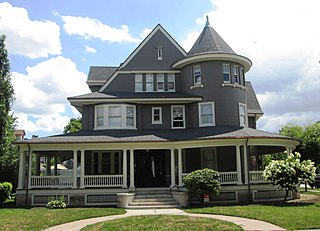
Prospect Park South is a small neighborhood in Flatbush, Brooklyn, New York City, located south of Prospect Park. It is included within the Prospect Park South Historic District, which was designated by the New York City Landmarks Preservation Commission in 1979 and listed on the National Register of Historic Places in 1983. The historic district is bounded by Church Avenue to the north, the BMT Brighton Line of the New York City Subway to the east, Beverley Road to the south, and between Stratford Road and Coney Island Avenue to the west.
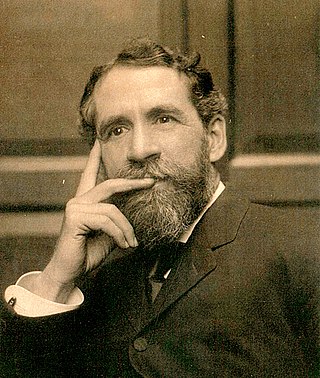
William Bunker Tubby was an American architect who was particularly notable for his work in New York City.

The Wilbraham at 282–284 Fifth Avenue or 1 West 30th Street, in the NoMad neighborhood of Manhattan, New York City, was built in 1888–90 as a bachelor apartment hotel. Its "bachelor flats" each consisted of a bedroom and parlor, with bathroom but no kitchen; the communal dining room was on the eighth floor. The building's refined and "extraordinarily well detailed" design in commercial Romanesque revival style – which owed much to the Richardsonian Romanesque developed by H.H. Richardson – was the work of the partners David and John Jardine. The Real Estate Record and Guide in 1890 called it "quite an imposing piece of architecture".
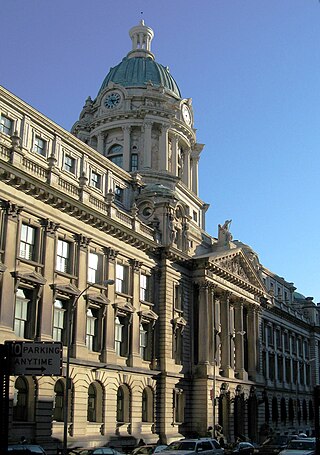
240 Centre Street, formerly the New York City Police Headquarters, is a building between Broome and Grand Streets in the Little Italy neighborhood of Manhattan, New York City.

The Flatbush Reformed Protestant Dutch Church, also known as the Flatbush Reformed Church, is a historic Dutch Reformed church – now a member of the Reformed Church in America – at 890 Flatbush Avenue in the Flatbush neighborhood of Brooklyn, New York City. The church complex consists of the church, cemetery, parsonage and church house.

Hanson Place Seventh-day Adventist Church, is an historic church at 88 Hanson Place between South Oxford Street and South Portland Avenue in the Fort Greene neighborhood of Brooklyn, New York City, which was built in 1857-60 as the Hanson Place Baptist Church. It was designed by George Penchard in the Early Romanesque Revival style. The building, which is constructed of brick on a brick foundation covered in stucco, features an entrance portico topped by a steeply pitched pediment supported by four Corinthian columns, while the side facade on South Portland features pilasters. The building's interior and exterior were restored in the 1970s. It has been a Seventh-day Adventist church since 1963.

52nd Police Precinct Station House and Stable is a historic police station located in Norwood in the Bronx, New York City. It was built 1904–1906 and is a three-story, red brick structure approximately 50 feet by 80 feet in size. It is in the style of a Tuscan villa. It features a 21-foot square clock tower with large polychrome terracotta clock faces on three sides.
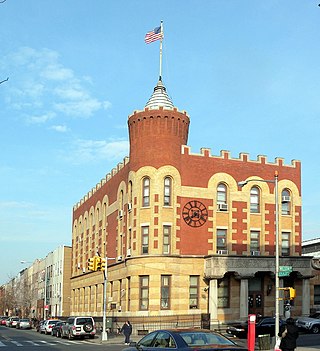
The 83rd Precinct Police Station and Stable is a historic police station and stable located at the corner of DeKalb and Wilson Avenues in Bushwick, Brooklyn, New York City. It was built in 1894 in the Romanesque Revival style to a design by William Tubby.

The Harlem Courthouse at 170 East 121st Street on the corner of Sylvan Place – a remnant of the former Boston Post Road – in the Harlem neighborhood of Manhattan, New York City, was built in 1891-93 and was designed by Thom & Wilson in the Romanesque Revival style. The brick, brownstone, bluestone, granite and terra cotta building features gables, archways, an octagonal corner tower and a two-faced clock. It was built for the Police and District Courts, but is now used by other city agencies.

The Edward Mooney House is a building at 18 Bowery, at the corner of Pell Street, in the Chinatown neighborhood of Manhattan, New York City. It was built between 1785 and 1789 for wealthy butcher Edward Mooney on land he purchased after it was confiscated from British Loyalist James De Lancey.

75th Police Precinct Station House is a historic police station located in Brooklyn, New York. It was built in 1886 and is a three-story, yellow brick building above a sandstone foundation and watertable in the Romanesque Revival style. It features a round corner tower and Norman-inspired projecting main entrance portico. The stable is a two-story brick building connected to the station house by a one-story brick passage. It ceased use as a police station in 1973 and later used by a local church.

The John Rankin House at 440 Clinton Street at the corner of Carroll Street in the Carroll Gardens neighborhood of Brooklyn, New York City was built in the Greek Revival style in 1840, at which time it stood by itself, surrounded by farmland and overlooking Upper New York Bay.
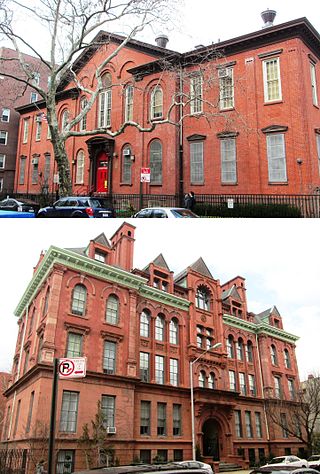
Public School 9 and Public School 9 Annex are two historic school buildings located at 227 and 279 Sterling Place, respectively, at Vanderbilt Avenue in the Prospect Heights neighborhood of Brooklyn, New York City.

Flatbush Town Hall at 35 Snyder Avenue between Flatbush and Bedford Avenues in the Flatbush neighborhood of Brooklyn, New York City, is a historic town hall built in 1874–75 and designed by John Y. Culyer in the High Victorian Gothic style in the Ruskinian mode. It is a two-story masonry building on a stone foundation, and features a three-story bell tower with a steep hip roof. The building dates from the time before the Town of Flatbush was integrated into the City of Brooklyn, in 1894, after which the building served as a magistrate's court and the New York City Police Department's 67th Police Precinct station.

The Albemarle–Kenmore Terraces Historic District is a small historic district located in the Flatbush neighborhood of Brooklyn, New York City. It consists of two short cul-de-sacs, Albemarle Terrace and Kenmore Terrace, off of East 21st Street, and the 32 houses on the two streets, as well as a four-family apartment building at the end of Albemarle Terrace. The New York City Landmarks Preservation Commission, which designated the district as a landmark in 1978, noted that the "terraces are distinguished by the uniform use of materials, height and color producing a harmonious effect".

The Carroll Gardens Historic District is a small municipal and national historic district located in the Carroll Gardens neighborhood of Brooklyn, New York City. The national district consists of 134 contributing residential rowhouses built between the 1860s and 1880s. They are two- and three-story brownstone buildings in the neo-Grec and late Italianate styles located in a rectangle bounded by Carroll, President, Smith, and Hoyt Streets. They feature uniform setbacks, even cornice lines and stoop levels, and fenced front yards and landscaped gardens. These were the result of surveyor Richard Butt, who in 1846 planned gardens in front of the brownstone houses in the oldest section of the neighborhood. The homes are set farther back from the street than is common in Brooklyn, and the large gardens became an iconic depiction of the neighborhood. All the houses in the district, which is afforded a degree of privacy by the street pattern that discourages through traffic on Carroll and President Streets, were built between 1869 and 1884.

The Cobble Hill Historic District is a municipal and national historic district located in the Cobble Hill neighborhood of Brooklyn, New York City. The national district consists of 796 contributing, largely residential buildings built between the 1830s and 1920s. It includes fine examples of Greek Revival, Italianate, and Queen Anne style row houses. Also in the district are a number of notable churches, including ones by Richard Upjohn and Minard Lafever, 1851–52). A number of early 20th century apartment buildings are part of the district as well.
This is a timeline and chronology of the history of Brooklyn, New York. Brooklyn is the most populous of New York City's boroughs, and was settled in 1646.

The Sunset Park Courthouse is a historic courthouse located at 4201 4th Avenue between 42nd and 43rd Streets, in the Sunset Park neighborhood of Brooklyn, New York City. It was built in 1930-31 and was designed by Mortimer Dickerson Metcalfe – the Deputy State Architect under Franklin B. Ware. Metcalfe used the Neoclassical style for the building, which is one of only two courthouses in the city he designed. The limestone-facaded building with Ionic columns has separate facades and entrances for the Municipal Court, on 42nd Street, and the Magistrates Court, on 43rd Street. The two facades are almost identical.
























